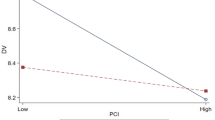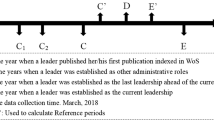Abstract
Studies that have examined organizations’ productivity and their leaders have found a rather weak relationship between a leader’s personal characteristics and organizational output. Similar empirical studies have also been conducted in relation to universities. These studies have concentrated on university leaders’ individual academic performance as a quantifiable individual characteristic. They have yielded rather contradictory results. In this study, I take a theoretical approach to quantify the effects of top leadership on university research performance. I assume that top leaders may influence university research productivity, but this influence should be visible. I theorize two types of university leader: the “strategic manager” who seeks to reallocate resources to make it of use for the whole university and the “politician” who reallocates resources to benefit certain research areas, especially the one they specialize in. It is hypothesized that (1) if a leader is a strategic manager, an increase in overall university research productivity would be observed; and (2) if a leader is a politician, there will be an increase in university performance in the research field in which the leader specializes. Using an extensive sample of Russian universities, it is demonstrated that while there is no observable relationship between overall university research productivity and the university leader’s academic excellence, there is a positive influence by university leader’s academic productivity on the research performance of his/her specific research field. This study finds evidence that leaders qua “politicians” can have a profound effect on their respective research areas’ productivity.
Similar content being viewed by others
Notes
In Russia, a senior official in an educational institution is called rector. For the purposes of this article, I take “rector,” president,” and “university leader” to be synonyms denoting a university’s or academic institution’s highest administrator.
The regressions presented here may favor institutions that have moved further in research than others. For this reason, I performed two control checks. First, I regressed leaders’ p-score in 2019 on university performance in 2010 to answer the question of whether today’s leaders are not simply a reflection of earlier university performance. For example, a scholar could have joined the university after and/or because of past good performance. The result was statistically insignificant. Second, to examine the effect of leaders on university performance, universities’ changes in CPPS were regressed on change in leader’s p-score. Again, I found no relationship. This means the original results can be trusted.
The national bureaucracy is represented by federal ministries, including the Ministry of Education and Science of Russia, Russia’s Government, and local governments.
References
Azoulay, P., Graff, J. S., Zivin, & Wang, J. (2010). Superstar extinction. The Quarterly Journal of Economics, 125(2), 549–589.
Badillo-Vega, R., Krücken, G., & Pineda, P. (2019). Changing analytical levels and methods of leadership research on university presidents. Studies in Higher Education, 1–13.
Baldridge, J. Victor. (1971). “Models of university governance: Bureaucratic, collegial, and political.”
Baltaru, R.-D. (2019). Do non-academic professionals enhance universities’ performance? Reputation vs. Organisation. Studies in Higher Education, 44(7), 1183–1196.
Bayers, N. K. (2005). Using ISI data in the analysis of German National and Institutional Research Output. Scientometrics, 62(1), 155–163.
Birnbaum, R. (1989). Presidential succession and institutional functioning in higher education. The Journal of Higher Education, 60(2), 123–135.
Bornmann, L., Mutz, R., Neuhaus, C., & Daniel, H.-D. (2008). Citation counts for research evaluation: Standards of good practice for analyzing bibliometric data and presenting and interpreting results. Ethics in Science and Environmental Politics, 8(1), 93–102.
Breakwell, G. M., & Tytherleigh, M. Y. (2008). UK university leaders at the turn of the 21st century: Changing patterns in their socio-demographic characteristics. Higher Education, 56(1), 109–127.
Breakwell, G. M., & Tytherleigh, M. Y. (2010). University leaders and university performance in the United Kingdom: Is it ‘who’ leads, or ‘where’ they lead that matters most? Higher Education, 60(5), 491–506.
Cannella, J., Albert, A., & Lubatkin, M. (1993). Succession as a sociopolitical process: Internal impediments to outsider selection. Academy of Management Journal, 36(4), 763–793.
Capano, G., Pritoni, A., & Vicentini, G. (2019). Do policy instruments matter? Governments’ choice of policy mix and higher education performance in western Europe. Journal of Public Policy, 1–27.
Carvalho, T., & Santiago, R. (2010). Still academics after all…. Higher Education Policy, 23(3), 397–411.
Chernyh, Aleksandr. (2014). “Vedushhie Vuzy Perevodjat Na Vneshnee Upravlenie [Leading Universities Transfer to External Management].” Kommersant, 2014, №111 edition.
Cohen, Michael D., and March, James G.. (1974). “Leadership and ambiguity: The American College President.”
Decramer, A., Smolders, C., Vanderstraeten, A., & Christiaens, J. (2012). The impact of institutional pressures on employee performance management systems in higher education in the low countries. British Journal of Management, 23, S88–S103.
Deem, R., & Brehony, K. J. (2005). Management as ideology: The Case of ‘new managerialism’ in higher education. Oxford Review of Education, 31(2), 217–235.
Diefenbach, Thomas. 2009. “New public management in public sector organizations: The dark sides of managerialistic ‘enlightenment.’” Public Administration 87 (4): 892–909.
Dyachenko, E., & Mironenko, A. (2019). Academic leadership through the prism of managerialism: The relationship between university development and rector’s specialization. Educational Studies Moscow, no., 1, 137–161.
Engwall, L. (2014). The recruitment of university top leaders: Politics, communities and markets in interaction. Scandinavian Journal of Management, 30(3), 332–343.
Engwall, L., Levay, C., & Lidman, R. (1999). The roles of university and college rectors. Higher Education Management, 11, 75–94.
Etzioni, A. (1959). Authority structure and organizational effectiveness. Administrative Science Quarterly, 43–67.
Fligstein, N. (1987). The intraorganizational power struggle: Rise of finance personnel to top leadership in large corporations, 1919-1979. American Sociological Review, 44–58.
Goodall, Amanda H. (2005). “Should top universities be led by top researchers and are they? A Citations Analysis.”
Goodall, A. H. (2009). Highly cited leaders and the performance of research universities. Research Policy, 38(7), 1079–1092.
Goodall, A. H., McDowell, J. M., & Singell, L. D. (2017). Do economics departments improve after they appoint a top scholar as chairperson? Kyklos, 70(4), 546–564.
Gumport, P. J. (2000). Academic restructuring: Organizational change and institutional imperatives. Higher Education, 39(1), 67–91.
Hambrick, D. C., & Mason, P. A. (1984). Upper echelons: The organization as a reflection of its top managers. Academy of Management Review, 9(2), 193–206.
Hamermesh, D. S., & Pfann, G. A. (2012). Reputation and earnings: The roles of quality and quantity in academe. Economic Inquiry, 50(1), 1–16.
Helmich, D. L. (1975). Corporate succession: An examination. Academy of Management Journal, 18(3), 429–441.
Henkel, M. (2002). Emerging concepts of academic leadership and their implications for intra-institutional roles and relationships in higher education. European Journal of Education, 37(1), 29–41.
Horta, H., Sato, M., & Yonezawa, A. (2011). Academic inbreeding: Exploring its characteristics and rationale in Japanese universities using a qualitative perspective. Asia Pacific Education Review, 12(1), 35–44.
Huang, F. (2017). Who leads China’s leading universities? Studies in Higher Education, 42(1), 79–96.
Julius, D. J., Victor Baldridge, J., & Pfeffer, J. (1999). A memo from Machiavelli. The Journal of Higher Education, 70(2), 113–133.
Kehm, Barbara M. (2013). “To Be or Not to Be? The impacts of the excellence initiative on the German System of Higher Education.” In Institutionalization of World-Class University in Global Competition, 81–97. Springer.
Kliucharev, G. A., & Neverov, A. V. (2018). Project ‘5-100’: Some interim results. RUDN Journal of Sociology, 18(1), 100–116.
Kraatz, M. S., & Moore, J. H. (2002). Executive migration and institutional change. Academy of Management Journal, 45(1), 120–143.
Marginson, S. (2014). Russian science and higher education in a more global era. Educational Studies Moscow, no., 4, 8–35.
Masten, S. E. (2006). Authority and commitment: Why universities, like legislatures, are not organized as firms. Journal of Economics and Management Strategy, 15(3), 649–684.
Moskaleva, O., Pislyakov, V., Sterligov, I., Akoev, M., & Shabanova, S. (2018). Russian Index of Science Citation: Overview and review. Scientometrics, 116(1), 449–462.
Muller, J. Z. (2018). The Tyranny of Metrics. Princeton University Press.
Musselin, C. (2007). Are universities specific organisations. Towards a Multiversity, 63–84.
Muzzin, L. J., & Tracz, G. S. (1981). Characteristics and careers of Canadian university presidents. Higher Education, 10(3), 335–351.
Panfilova, T. V. (2011). Higher education reform in Russia: Democratization or bureaucratization? Russian Education and Society, 53(7), 25–39.
Parker, L. D. (2013). Contemporary university strategising: The financial imperative. Financial Accountability & Management, 29(1), 1–25.
Pfeffer, J. (1981). Power in Organizations (Vol. 33). Pitman Marshfield.
Pfeffer, J., & Moore, W. L. (1980). Power in university budgeting: A replication and extension. Administrative Science Quarterly, 637–653.
Pfeffer, J., & Salancik, G. R. (1974). Organizational decision making as a political process: The case of a university budget. Administrative Science Quarterly, 135–151.
Poldin, Oleg, Nataliya Matveeva, Ivan Sterligov, and Maria Yudkevich. (2017). “Publication activities of Russian universities: The effects of Project 5–100.” Educational Studies Moscow, no. 2: 59.
Romanov, P. (2008). Quality evaluation in social services: Challenges for new public management in Russia. Mixes, Matches, and Mistakes: New Public Management in Russia and the Former Soviet Republics, 9–53.
Rowley, Daniel James, and Sherman, Herbert (2003). “The special challenges of academic leadership.” Management Decision.
Salancik, Gerald R., & Jeffrey Pfeffer. 1974. “The bases and use of power in organizational decision making: The Case of a university.” Administrative Science Quarterly, 453–73.
Salmi, J. (2016). Excellence initiatives to create world-class universities. International Higher Education, no., 87, 17–18.
Shibanova, E., Yu, D., Platonova, P., & Lisyutkin, M. A. (2018). The 5–100 Project university development trends and patterns. Russian Education and Society, 60(8–9), 682–715.
Singell Jr, L. D., & Tang, H.-H. (2013). Pomp and circumstance: University presidents and the role of human capital in determining who leads US Research Institutions. Economics of Education Review, 32, 219–233.
Sīle, L., Pölönen, J., Sivertsen, G., Guns, R., Engels, T. C. E., Arefiev, P., Dušková, M., Faurbæk, L., Holl, A., & Kulczycki, E. (2018). Comprehensiveness of national bibliographic databases for social sciences and humanities: Findings from a European survey. Research Evaluation, 27(4), 310–322.
Smolentseva, Anna. (2015). “Globalization and the research mission of universities in Russia.” In Higher Education in the BRICS Countries, 399–421. Springer.
Sokolov, M. (2021). “Can the Russian research policy be called neo-liberal? A study in comparative sociology of quantification.” Europe-Asia Studies, no. 1.
Sokolov, M., Lopatina, S., & Yakovlev, G. (2018). From Partnerships to Bureaucracies: The constitutional evolution of Russian universities. Educational Studies Moscow, 3(eng), 120–145.
Staw, B. M. (1980). The Consequences of Turnover. Journal of Occupational Behaviour, 253–273.
Taylor, J. (2011). The assessment of research quality in UK universities: Peer review or metrics? British Journal of Management, 22(2), 202–217.
Thornton, P. H., & Ocasio, W. (1999). Institutional Logics and the historical contingency of power in organizations: Executive succession in the higher education publishing industry, 1958–1990. American Journal of Sociology, 105(3), 801–843.
Tight, M. (2004). Research into higher education: An a-theoretical community of practice? Higher Education Research and Development, 23(4), 395–411.
Weick, K. E. (1976). Educational organizations as loosely coupled systems. Administrative Science Quarterly, 1–19.
Yielder, J., & Codling, A. (2004). Management and leadership in the contemporary university. Journal of Higher Education Policy and Management, 26(3), 315–328.
Zald, M. N. (1965). Who shall rule? A political analysis of succession in a large welfare organization. The Pacific Sociological Review, 8(1), 52–60.
Zarate, R. L. (2007). Four trajectories of rectors in mexican public universities. Higher Education, 54(6), 795–817.
Zhang, Y., & Rajagopalan, N. (2004). When the Known devil is better than an unknown god: An empirical study of the i consequences of relay CEO successions. Academy of Management Journal, 47(4), 483–500.
Author information
Authors and Affiliations
Corresponding author
Additional information
Publisher’s note
Springer Nature remains neutral with regard to jurisdictional claims in published maps and institutional affiliations.
Rights and permissions
About this article
Cite this article
Gerashchenko, D. Academic leadership and university performance: do Russian universities improve when they are led by top researchers?. High Educ 83, 1103–1123 (2022). https://doi.org/10.1007/s10734-021-00732-5
Accepted:
Published:
Issue Date:
DOI: https://doi.org/10.1007/s10734-021-00732-5




